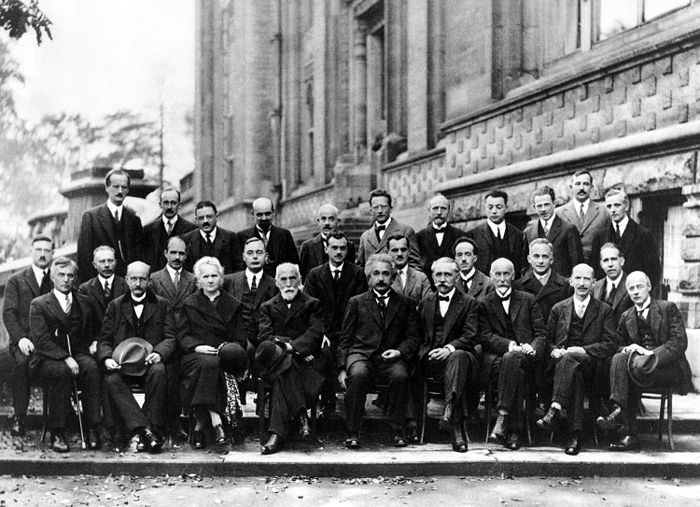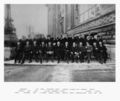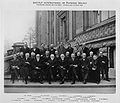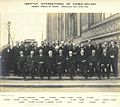- Solvay Conference
-
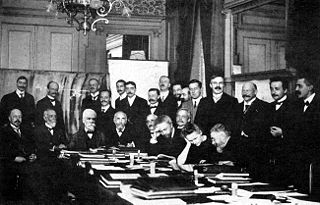 Photograph of the first conference in 1911 at the Hotel Metropole. Seated (L-R): W. Nernst, M. Brillouin, E. Solvay, H. Lorentz, E. Warburg, J. Perrin, W. Wien, M. Curie, and H. Poincaré. Standing (L-R): R. Goldschmidt, M. Planck, H. Rubens, A. Sommerfeld, F. Lindemann, M. de Broglie, M. Knudsen, F. Hasenöhrl, G. Hostelet, E. Herzen, J.H. Jeans, E. Rutherford, H. Kamerlingh Onnes, A. Einstein and P. Langevin.
Photograph of the first conference in 1911 at the Hotel Metropole. Seated (L-R): W. Nernst, M. Brillouin, E. Solvay, H. Lorentz, E. Warburg, J. Perrin, W. Wien, M. Curie, and H. Poincaré. Standing (L-R): R. Goldschmidt, M. Planck, H. Rubens, A. Sommerfeld, F. Lindemann, M. de Broglie, M. Knudsen, F. Hasenöhrl, G. Hostelet, E. Herzen, J.H. Jeans, E. Rutherford, H. Kamerlingh Onnes, A. Einstein and P. Langevin.
The International Solvay Institutes for Physics and Chemistry, located in Brussels, were founded by the Belgian industrialist Ernest Solvay in 1912, following the historic invitation-only 1911 Conseil Solvay, the first world physics conference. The Institutes coordinate conferences, workshops, seminars, and colloquia.
Following the initial success of 1911, the Solvay Conferences (Conseils Solvay) have been devoted to outstanding preeminent open problems in both physics and chemistry. The usual schedule is every three years, but there have been larger gaps.
Contents
First conference
Hendrik A. Lorentz was chairman of the first Solvay Conference held in Brussels in the autumn of 1911. The subject was Radiation and the Quanta. This conference looked at the problems of having two approaches, namely the classical physics and quantum theory. Albert Einstein was the second youngest physicist present (the youngest one was Lindemann). Other members of the Solvay Congress included such luminaries as Marie Skłodowska-Curie and Henri Poincaré. (See image for attendee list.)
Fifth conference
Perhaps the most famous conference was the October 1927 Fifth Solvay International Conference on Electrons and Photons, where the world's most notable physicists met to discuss the newly formulated quantum theory. The leading figures were Albert Einstein and Niels Bohr. Einstein, disenchanted with Heisenberg's "Uncertainty Principle," remarked "God does not play dice." Bohr replied, "Einstein, stop telling God what to do." (See Bohr-Einstein debates.) Seventeen of the twenty-nine attendees were or became Nobel Prize winners, including Marie Curie, who alone among them, had won Nobel Prizes in two separate scientific disciplines.
This conference was also the culmination of the struggle between Einstein and the Scientific Realists, who wanted strict rules of scientific method as laid out by Charles Peirce and Karl Popper, versus Bohr and the Instrumentalists, who wanted looser rules based on outcomes. Starting at this point, the instrumentalists won, instrumentalism having been seen as the norm ever since[1] although the debate has been actively continued by the likes of Alan Musgrave.
A. Piccard, E. Henriot, P. Ehrenfest, E. Herzen, Th. De Donder, E. Schrödinger, J.E. Verschaffelt, W. Pauli, W. Heisenberg, R.H. Fowler, L. Brillouin;
P. Debye, M. Knudsen, W.L. Bragg, H.A. Kramers, P.A.M. Dirac, A.H. Compton, L. de Broglie, M. Born, N. Bohr;
Fifth conference participants, 1927. Institut International de Physique Solvay in Leopold Park.
I. Langmuir, M. Planck, M. Curie, H.A. Lorentz, A. Einstein, P. Langevin, Ch. E. Guye, C.T.R. Wilson, O.W. RichardsonSolvay conferences on physics
No Year Title Translation Chair 1 1911 La théorie du rayonnement et les quanta The theory of radiation and quanta Hendrik Lorentz (Leiden) 2 1913 La structure de la matière The structure of matter 3 1921 Atomes et électrons Atoms and electrons 4 1924 Conductibilité électrique des métaux et problèmes connexes Electric conductivity of metals and related problems 5 1927 Electrons et photons Electrons and photons 6 1930 Le magnétisme Magnetism Paul Langevin (Paris) 7 1933 Structure et propriétés des noyaux atomiques Structure & properties of the atomic nucleus 8 1948 Les particules élémentaires Elementary particles William Lawrence Bragg (Cambridge) 9 1951 L'état solide The solid state 10 1954 Les électrons dans les métaux Electrons in metals 11 1958 La structure et l'évolution de l'univers The structure and evolution of the universe 12 1961 La théorie quantique des champs Quantum field theory 13 1964 The Structure and Evolution of Galaxies J. Robert Oppenheimer (Princeton) 14 1967 Fundamental Problems in Elementary Particle Physics R. Møller (Copenhagen) 15 1970 Symmetry Properties of Nuclei Edoardo Amaldi (Rome) 16 1973 Astrophysics and Gravitation 17 1978 Order and Fluctuations in Equilibrium and Nonequilibrium Statistical Mechanics Léon van Hove (CERN) 18 1982 Higher Energy Physics 19 1987 Surface Science F. W. de Wette (Austin) 20 1991 Quantum Optics Paul Mandel (Brussels) 21 1998 Dynamical Systems and Irreversibility Ioannis Antoniou (Brussels) 22 2001 The Physics of Communication 23 2005 The Quantum Structure of Space and Time David Gross (Santa Barbara) 24 2008 Quantum Theory of Condensed Matter Bertrand Halperin (Harvard) 25 2011 The theory of the quantum world David Gross Solvay conferences on chemistry
No Year Title Translation Chair 1 1922 Cinq Questions d'Actualité Five topical questions William Pope (Cambridge) 2 1925 Structure et Activité Chimique Structure and Chemical Activity 3 1928 Questions d'Actualité Topical Questions 4 1931 Constitution et Configuration des Molécules Organiques Constitution and Configuration of Organic Molecules 5 1934 L'Oxygène, ses réactions chimiques et biologiques Oxygen, and its chemical and biological reactions. 6 1937 Les vitamines et les Hormones Vitamins and Hormones Frédéric Swarts (Ghent) 7 1947 Les Isotopes Isotopes Paul Karrer (Zurich) 8 1950 Le Mécanisme de l'Oxydation The mechanism of oxidation 9 1953 Les Protéines Proteins 10 1956 Quelques Problèmes de Chimie Minérale Some Problems of Inorganic Chemistry 11 1959 Les Nucléoprotéines Nucleoproteins Alfred Rene Ubbelohde (London) 12 1962 Transfert d'Energie dans les Gaz Energy transfer in gases 13 1965 Reactivity of the Photoexcited Organic Molecule 14 1969 Phase Transitions 15 1970 Electrostatic Interactions and Structure of Water 16 1976 Molecular Movements and Chemical Reactivity as conditioned by Membranes, Enzymes and other Molecules 17 1980 Aspects of Chemical Evolution 18 1983 Design and Synthesis of Organic Molecules Based on Molecular Recognition Ephraim Katchalski (Rehovot) & Vladimir Prelog (Zurich) 19 1987 Surface Science F. W. de Wette (Austin) 20 1995 Chemical Reactions and their Control on the Femtosecond Time Scale Pierre Gaspard (Brussels) 21 2007 From Noncovalent Assemblies to Molecular Machines Jean-Pierre Sauvage (Strasbourg) 22 2010 Quantum Effects in Chemistry and Biology Graham Fleming (Berkeley) References
- ^ Leplin, J. (1984). Scientific Realism. [University of California Press]]. ISBN 9780520051553. http://books.google.com/books?id=UFCpopYlB9EC.
Further reading
- Straumann, N. (2011). "On the first Solvay Congress in 1911". European Physical Journal H. doi:10.1140/epjh/e2011-20043-9.
External links
- Solvay Conferences on Physics
- Solvay Conferences on Chemistry
- Institut international de physique Solvay
- Irving Langmuir's “home movie” shot of the 1927 Solvay Conference
- The Solvay Conference of 1927 Interactive photograph of the Fifth Solvay Conference
- Proceedings 1911
- Proceedings 1913
- A page from the American Institute of Physics A brief overview of the argument of the Fifth Conference.
- Footage of the 1927 Solvay conference
- Quantum Theory at the Crossroads: Reconsidering the 1927 Solvay Conference A 2009 book giving the first complete translation of the proceedings into English, with extended revisionist commentary.
Categories:- Chemistry conferences
- Physics conferences
- Recurring events established in 1912
Wikimedia Foundation. 2010.

